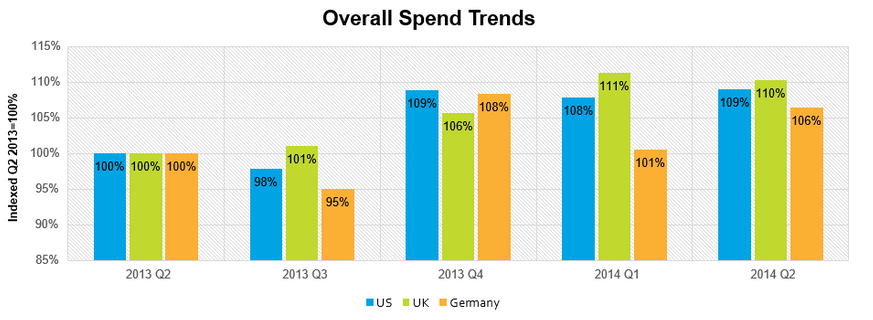Ahead of Google’s quarterly earnings announcement, Adobe today released its latest ad data report for search ads. Based on what the company is seeing on its Marketing Cloud, U.S. search ad spend grew about 9 percent year-over-year, mostly through click growth. For the full year, which includes the traditionally stronger fourth quarter, Adobe expects that spend will increase between 10 and 12 percent.
Unsurprisingly, the leader in search ad spend is Google, which currently commands 78 percent of this market among Adobe’s customers. That’s down slightly from 80 percent in the first quarter and 82 percent in the last quarter of 2013, but in line with the 78 percent Adobe reported a year ago. There may be some seasonality at play here, but overall, Google’s position seems to be holding strong.
The other 22 percent go to Yahoo/Bing, which managed to increase its U.K. market share to 8.8 percent, but is a negligible player in Germany, where Google owns 96 percent of the search ad market (and its monopoly position there also explains why many European governments are more critical of the company than the U.S. government).

The overall analysis is based on looking at over 200 billion search impressions worth roughly $2 billion from over 500 Marketing Cloud users that use Adobe’s programmatic advertising platform.
Cost-per-click (CPC), one of the main indicators of Google’s success, is up slightly by 4 percent year-over-year. On Bing, however, CPC is down 6 percent.
Maybe one of the most interesting data points of the report is that search ad spend targeting tablets is stalling. It currently accounts for about 14 percent all search spend, but that’s only up from 12 percent 10 months ago. At the same time, mobile ad spend passed tablet spend and rose from 10 percent to 15 percent.

The other interesting factoid is that click-through rates on Google rose by 20 percent. Adobe attributes this shift at least partly to Google’s new ad formats, which now look like an organic part of the search results page (and is hence more likely to trick people into clicking ads). Adobe found that these rates are up across different industries.
